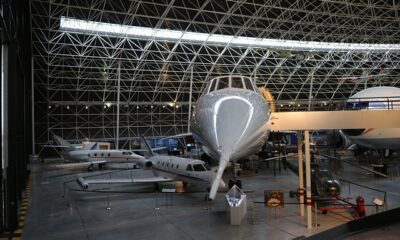Aviation
Air France retires first Airbus A380

Air France retires first Airbus A380
According Aerotime Air France retired its first Airbus A380, marking the beginning of the withdrawal process of its fleet of ten superjumbos. The aircraft should soon be returned to the lessor.
After carrying out a last flight between Johannesburg Airport (JNB) and its base of Paris Charles de Gaulle (CDG), the A380, registered F-HPJB, was sent to Malta on November 23, 2019. It was the first A380 that entered service with the French national carrier in February 2010.
As per Airwaysmag Air France claims that the current competitive environment limits the markets in which the A380 can profitably operate. “With four engines, the A380 consumes 20-25% more fuel per seat than new generation long-haul aircraft and therefore emits more CO2,” says the airline.
“Increasing aircraft maintenance costs, as well as necessary cabin refurbishments to meet customer expectations reduce the economic attractiveness of Air France’s A380s even further. Keeping this aircraft in the fleet would involve significant costs, while the aircraft program was suspended by Airbus earlier in 2019.”
The comments were made as part of a wider plan and announcement by the airline, who with its partners KLM, have laid out a long term fleet regeneration program with the latest widebody aircraft the A350 and the Boeing 787 Dreamliner.

Aviation
Exploring the Different Types of Helicopter Rotor Systems and the Science Behind Them

Helicopters are unique aircraft that use rotating blades, called rotors, to generate lift and enable flight. The design of these rotor systems is crucial because it affects how helicopters perform, maneuver, and respond to different flying conditions.
There are several types of helicopter rotor systems, each with its own advantages and specific uses. Understanding these systems helps us appreciate the engineering behind helicopters and their diverse capabilities, from search and rescue missions to military operations and aerial photography.
In this Video, we will explore the main types of helicopter rotor systems and how they contribute to the helicopter’s functionality and performance.
1. Single Rotor System
The single rotor system is characterized by a single main rotor blade that is responsible for generating lift. To counteract the torque produced by this rotor, a tail rotor is used. This setup is essential for maintaining directional control and stability during flight.
Uses: This design is prevalent in most conventional helicopters, including iconic models such as the Bell 206 and the Robinson R22. The simplicity of the single rotor system not only reduces mechanical complexity but also enhances efficiency. As a result, it is favored for a variety of applications, including aerial tours, law enforcement, and emergency medical services, where reliability and straightforward operation are paramount.
2. Tandem Rotor System
The tandem rotor system features two parallel rotors of equal size that rotate in opposite directions. This counter-rotation helps to cancel out the torque that each rotor would otherwise produce, resulting in a balanced and stable flight profile.
Uses: This configuration is typically employed in heavy-lift helicopters, such as the CH-47 Chinook. The tandem design allows for an increased payload capacity and enhanced stability, making it particularly effective for transporting troops, equipment, and supplies in military operations, as well as for civilian applications like logging and construction, where heavy lifting is required.
3. Coaxial Rotor System
The coaxial rotor system consists of two rotors mounted one above the other on the same mast, rotating in opposite directions. This innovative design minimizes the need for a tail rotor, allowing for a more compact helicopter structure.
Uses: Coaxial rotor systems can be found in helicopters such as the Kamov Ka-50. This design offers several advantages, including enhanced lift capabilities, improved maneuverability, and better control in various flight conditions. These features make it particularly suitable for military applications, where agility and quick response times are crucial, as well as for specific civilian operations that require high performance in tight spaces.
4. Intermeshing Rotor System
The intermeshing rotor system consists of two rotors that rotate in opposite directions while intersecting each other, but without colliding. This unique configuration creates a highly efficient aerodynamic profile.
Uses: This system is utilized in helicopters like the Kaman K-MAX, designed specifically for heavy lifting and aerial work. The intermeshing rotors provide remarkable stability and lift capabilities, making it particularly effective for operations in confined spaces, such as urban environments or dense forests. It is ideal for missions that involve heavy external loads, including construction, firefighting, and disaster relief efforts.
5. Transverse rotor system
The transverse rotor system has two parallel rotors that spin in opposite directions, improving lift and stability. This design enhances the aircraft’s aerodynamic efficiency and maneuverability.
A notable example of this system is the V-22 Osprey, a tiltrotor aircraft that merges helicopter vertical lift with the speed of a fixed-wing plane. allowing the Osprey to operate in tough environments like urban areas and remote locations. It can carry heavy loads and personnel, making it suitable for troop transport, search and rescue, medical evacuation, and logistical support in military operations. Overall, the transverse rotor system enhances the V-22 Osprey’s effectiveness and operational flexibility.
6. Compound Rotor System
The compound rotor system combines traditional rotor systems with fixed wings and other aerodynamic features to enhance efficiency and speed. This hybrid approach allows for greater aerodynamic performance than standard rotorcraft.
Uses: Advanced helicopters like the Sikorsky X2 and Boeing’s DBF (Defiant) utilize the compound rotor system. These helicopters are designed for higher speeds and longer ranges, making them suitable for military operations, search-and-rescue missions, and law enforcement tasks where rapid response and extended operational capabilities are essential.
7. NOTAR system
NOTAR system replaces the traditional tail rotor with a ducted fan and directional airflow to counter the torque from the main rotor. It works by pushing air through the tail boom and out through side vents, creating thrust that stabilizes the helicopter. This design reduces noise, boosts safety, and cuts down on maintenance.
Uses: The NOTAR system is found in helicopters like the MD 520N and MD 902 Explorer. Without an exposed tail rotor, it lowers the risk of rotor strikes, making it safer for operations in tight spaces. Its quieter performance is ideal for missions where low noise is needed, such as urban air operations, police work, and medical evacuations.
-

 Aviation2 months ago
Aviation2 months agoNew EU Carry-On Rules Begin September 2024: What to Expect
-

 Aviation2 months ago
Aviation2 months agoBoeing confirms 797: A New Era for Mid-Size Aircraft
-

 Aviation2 months ago
Aviation2 months agoLockheed and Tata Team Up to Build C-130J MRO Facility in India
-

 Aviation1 month ago
Aviation1 month agoMicrosoft Flight Simulator Raises $3 Million to Bring Back the An-225 Mriya
-

 Tech2 months ago
Tech2 months agoChina Developing Jet to Travel Anywhere in Two Hours
-

 Airlines2 months ago
Airlines2 months agoQantas Engineers Stage Walkout Over Cost of Living Concerns
-

 Aviation2 months ago
Aviation2 months agoBoeing Offers 25% Pay Increase & Promise to Build Next Plane in Seattle
-

 Airlines1 month ago
Airlines1 month agoQatar Citizens Can Travel to the United States Without a Visa








